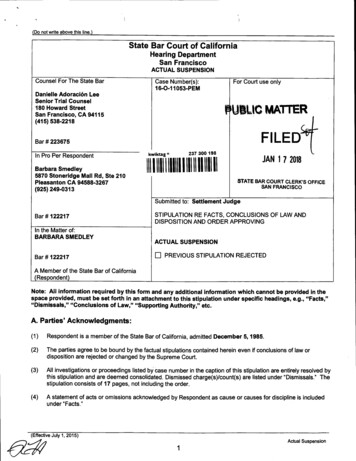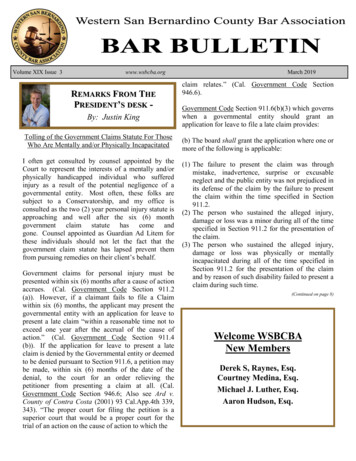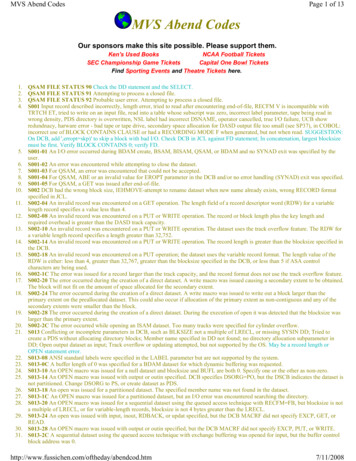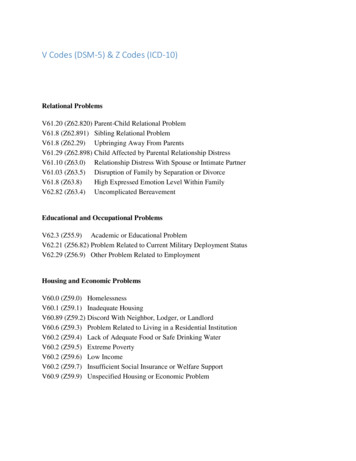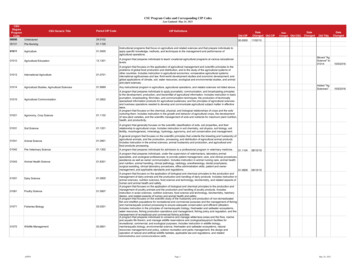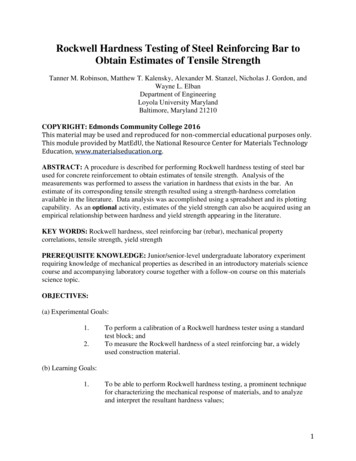
Transcription
Bar Codes in theManufacturing ProcessAZEBRABLACK&WHITEPAPERCoridian Technologies, Inc1725 Lake Drive W Chanhassen MN 55317(952)361-9980 (952)391-9981 Faxwww.coridian.com info@coridian.com
Copyrights 2006 ZIH Corp. All product names and numbers are Zebra trademarks, and Zebra and the Zebra head graphic are registeredtrademarks of ZIH Corp. All rights reserved. All other trademarks are the property of their respective owners.Unauthorized reproduction of this document or the software in the label printer may result in imprisonment of up to one yearand fines of up to 10,000 (17 U.S.C.506). Copyright violators may be subject to civil liability.
Manufacturers depend on a well-coordinated chain of events to make their operations work effectively. Today’sbusiness software packages, such as enterprise resource planning (ERP), materials management, productioncontrol and supply chain execution applications depend on real-time data collection systems to provideinformation crucial to the entire manufacturing operation. As more companies turn to enterprise-wide softwarefor process improvement and cost reduction, there is a significant opportunity to enhance these systems byadding bar coding and radio frequency identification (RFID) applications throughout manufacturing facilities.This document takes you further into a production facility and provides an overview of the many, growingapplications for bar coding and RFID in manufacturing.Compliance LabelingEver since the Wrigley Company put a Universal Product Code (UPC)label on a pack of gum, bar codes have been a key component of theindustry. Manufacturers’ shipping labels are often designed to meetthe needs of their customers. Many organizations in all businesssectors, including Wal-Mart, General Motors, Boeing, the U.S.Department of Defense and various regulatory and safety bodiesrequire compliance labels on all incoming packaging. Manycompliance programs have evolved beyond traditional bar coding andrequire two-dimensional (2D) bar code symbols or RFID tags. Othercompliance programs require permanent identification for parts,components and finished products for traceability and productgenealogy applications. These programs are most prevalent in theaerospace, automotive, defense and electronics industries, but theprinciples are widely used.Compliance labels and tags can also be useful within a manufacturer’s own facility for timely and accurate datacollection. Bar code and RFID labels provide serial numbers and other important product information thatvarious production, inventory and shipping systems can use to run effectively. Bar code and RFID readers anddata collection terminals quickly, accurately and automatically capture this information and communicate witha computer host that processes the data.Two Types of ManufacturingThere are two basic types of manufacturing: discrete and process. Discrete manufacturing (e.g., automobilemanufacturing) relies on a bill of materials (BOM) to identify the large number of specific parts orsubassemblies and their quantities. Process manufacturing (e.g., chemical processing) is formula-based. It relieson weights and measures (pounds or gallons) of raw ingredients. In both cases, bar coding and RFID are used toidentify component parts or containers of ingredients, work-in-process, finished goods inventory and productspackaged for shipping.What follows is a step-by-step journey through a typical manufacturing facility. At each step, we’ll explain howand why bar coding or RFID is used.1
Step 1: ReceivingRaw materials or sub-assemblies arriving at a manufacturer’sreceiving dock have ID labels on their packaging to meet thecompany’s requirements for materials management. Otherwise, thereceiving department logs in the item and typically generates a 4–by6-inch or smaller bar code label to identify the material before it ismoved to an inventory location or inspection station. These labelsare produced with either an industrial thermal printer at thereceiving area, or perhaps a mobile printer mounted on a lift truckor worn on a shoulder strap. Remote printing at receiving and otherareas throughout the facility helps productivity by saving workersfrom having to travel to central locations to pick up labels.Decentralized printers can be linked to manufacturing systems andother enterprise applications through a variety of networking techniques, including secure IEEE 802.11-standard wirelesscommunication.Step 2: Raw Material InventoryA warehouse operator transfers the material to an inventorylocation. These sites often are identified with bar code location codesprinted on reflective labels. The reflective material (such as Zebra’s8000T RetroScan labels) allows readability from scanners up to 30feet away. Bar codes and RFID provide accuracy because theoperator scans both the package and the new storage location tocomplete the transfer operation and automatically record it in thesystem.Step 3: PickingA work order from the factory floor signals the picking operation toretrieve raw materials or parts from inventory. The workers usingfork trucks, carts or just walking the aisles are directed to the exactinventory location where the material is located and told how manyof each part to pick. Bar codes are scanned again to complete thetransfer operation. Reusable totes and containers used for pickingand material handling operations can be identified with permanentbar code or RFID labels for automatic tracking. In some cases,inventory labels may need to be updated or corrected in thewarehouse to replace damaged labels or to identify a change inquantity. Secure, wireless mobile printers mounted to lift truckssimplify this operation. Pickers who don’t work from vehicles oftenuse mobile or cart-mounted printers to produce labels on demand.RFID tags are read/write, so tag data can be updated without generating a new label. This feature is sometimes used to encode reusabletotes with a tracking number that associates the tote with thespecific order it is being used to fill.2
Step 4: Work-in-Process (WIP)The picked materials are checked to confirm the right parts andquantities were picked. Labels on each item are scanned for confirmation. As the parts are used in assembly, bar code or RFID labelsenable part tracking throughout the process—showing that it wasconsumed in an assembly, or was set aside due to a defect or otherissue. As parts become assemblies, additional bar code labels can beadded to identify and track the assembly by its new part number, orthe RFID label can be updated.Bar codes and RFID labels produced on durable and specializedmedia enable materials to be automatically identified and tracked inchallenging production environments. Thermal printers supportmedia that withstands heat treatment and other temperatureextremes, exposure to chemicals, cleaners and solvents, UV light,abrasion, humidity and condensation, and can meet stringent cleanroom and electrostatic discharge (ESD) requirements. RFID iscommonly used in environments where optical identification ofbar codes is impossible because of low light, no visibility, or otherconditions.In some process manufacturing, bar code and RFID labels are usedto identify transitions between lots or batches. For example, inpaper, film, or coatings manufacturing, splices can be requiredbetween batches used to complete a master roll of material. Thesplice point is identified with a bar code label that identifies the timeand batch number of the new material.Step 5: Product IdentificationThermal-transfer printing is widely used to print nameplate identification labels on-demand with serial number information and/orUL/CSA regulatory content. Synthetic label materials ensure thedurability of the image and the label’s longevity. Most products andcomponents that require a UID two-dimensional bar code tocomply with U.S. Department of Defense lifetime identificationrequirements can be successfully labeled using thermal-transferprinters and media. Thermal-transfer printing also meets manylifetime marking requirements in the aerospace, automotive,electronics and other industries.For electrical products, labels with UL/CSA logos or content areunique because only specific label supplies tested by UL or CSA areapproved. Zebra offers hundreds of tested, UL/CSA-approved labeland ribbon combinations for this purpose. Pre-approved label andribbon combinations from Zebra can save manufacturers extensivepaperwork and product delays when they need a new type of labelor one for a new application. Contact a Zebra supplies specialistwhen regulatory requirements exist for a label application.3
Step 6: Finished GoodsAt the completion of the packaged assembly in discretemanufacturing, or the packaging of the product in process manufacturing, bar codes are used to identify the package contents. If no salesorder for this product exists, the fork truck operator collects thepackage and takes it to a finished goods warehouse location forinventory. Bar codes on the product and at the warehouse locationare scanned to complete the transfer operation.A customer’s sales order signals the picking operation to retrieve theproduct from finished goods inventory. Thanks to the informationretrieved from the label, the operator knows the precise inventorylocation and picks the inventory for shipping. Bar codes or RFIDtags are read to confirm the correct item was picked and to recordthe transfer to the shipping department.Step 7: ShippingThe bar code on the package is scanned in the shipping departmentto acknowledge receipt. New labels are printed with shipping information. These labels are typically 4-by-six-inch paper labels withcustomer- or carrier-specific compliance formats. Complianceformats may include 2D symbologies such as PDF417 found in theGM 1724 label standard series, or Maxicode symbology for UPSshipping labels. RFID compliance labels still have a bar code component.If multiple labeled packages are combined on a pallet and shrinkwrapped, a larger, master label is often required for the pallet. Paperlabels are commonly used for these applications, but syntheticmaster labels (such as Zebra’s PolyPro 4000T) should be specified ifthe shrink-wrapping is recyclable. Other regulatory orenvironmental requirements may impact the label format, content orlabel materials.The U.S. Department of Transportation (DOT) and National Fire Protection Association (NFPA) are among theorganizations with mandatory regulations for labeling of chemical packaging and containers used in transportation. Although many of these labels contain static information, on-demand, thermal-transfer printing ontopreprinted label materials can provide a substantial cost savings by reducing the storage of expensive labelinventory and waste that occurs when adhesive backings degrade.4
Labeling Relates to Manufacturing TrendsE-CommerceThe impact of e-commerce has reached far beyond consumers purchasing books and compact discs online.Business-to-business online purchasing now accounts for the bulk of e-commerce transactions, and it is steadilyincreasing. Today, instead of a small number of large, infrequent product shipments to a distributor, manufacturers often are asked to drop-ship individual packages directly to the end-users. As a result, the number ofshipments (and shipping labels) required is dramatically higher, and so is the effectiveness of on-demandprinting compared to batch.JIT OperationsTo reduce inventory levels and overall inventory carrying costs, resellers are pushing much of their earlierstocking levels of inventory back to the manufacturer and demanding faster response to their orders.Manufacturers are responding similarly with their parts suppliers. To avoid stock-outs or production downtime,manufacturers and other supply chain participants are investing heavily in methods that deliver inventory justin time (JIT) — the precise quantity of the specific product required, at precisely the time it is needed. Withincreased customization and make-to-order (MTO) requirements, many manufacturers also need to providecomponents just-in-sequence to support their customers’ manufacturing processes. As a result, JIT systems relyon bar code and RFID reading and printing to track products accurately and in real time.This improvement in tracking lowers economic order quantity (EOQ) requirements by notifying part suppliersearlier about inventory replenishment requirements (EOQ levels alert purchasing to reorder parts). The result islower inventory carrying costs, higher inventory turnover rates, reduced misplaced inventory and more room tomanufacture product cost-effectively.ERP and WMS SystemsMajor manufacturers have implemented or at least initiated an ERP, warehouse management systems (WMS),or related software applications to manage their enterprise. These systems allow JIT purchasing to work bytracking process components throughout the supply chain. By knowing what is required by when, and what isavailable from where, the ERP system optimizes the timing and efficiency of the purchasing, production, andfulfillment components of its business.This system investment completely depends on the ability to track each component part, subassembly, andfinished product from the raw material supplier to the end-user. Data collection for each transaction is criticalin providing the ERP system with continuous status updates. Likewise, the necessary data collection steps arenot possible unless identification is provided for each component part, subassembly, and finished product.Automated data collection is the keystone of the ERP system. The result: both the parts labeling volume and thenumber of locations that perform bar code printing within a manufacturing plant increase.After the implementation of an ERP system it often takes between two and four years before companies have thebudget available to implement label printing solutions. Only in a project’s second phase will middlewarevendors specify the data collection and label printing hardware for the selected ERP solution. Thermal printingsolutions that can interface directly with SAP, Oracle and other enterprise software systems are often easier tointegrate and maintain and more cost effective than systems that require middleware, print servers or customprogramming. Companies should also consider bar code label printers that can be upgraded to support RFIDtag encoding in the future if they currently are affected, or anticipate being affected by an RFID compliancemandate.5
Wireless Communication and Network AdministrationWireless communication in manufacturing is growing rapidly because it allows real-time data collection inremote portions of the plant. With wireless technology, label printers can operate on location, eliminating theneed for an employee to run back and forth between a centrally located printer and the point requiring a label.For example, mobile printers with wireless capabilities are mounted on forklifts to provide on-demand printingwhenever and wherever a label is needed. The information is uploaded immediately to the ERP system insteadof synchronizing at a shift change. This increases productivity and reduces errors.The growing use of networked printers with enterprise systems, increases the importance of network administration. Managing the network by remotely configuring or monitoring printers, or updating label formats, isbecoming increasingly valuable, especially as advancements in security evolve and network administrators lookto update their networked devices. Printers that automatically communicate situations requiring attention, suchas the completion of a roll of labels or an error condition, improve uptime and are critical to the efficient operation of the plant.Global Supply ChainsWith companies transacting business around the world, it’s more important than ever to be able to identifyparts, products and pallets of goods – plus their ports of call – in different languages on the same label.Organizations that need to print shipping labels in multiple languages have been faced with implementingcostly custom output solutions, or to treat characters as graphics, which results in very slow label printing.Printer support for Unicode simplifies international character printing and eliminates many modification andsupport expenses. A Unicode-enabled printer can seamlessly output any language, with no need for an operatorto select the language, font, codepage or otherwise configure or adjust the printer.Thermal Printing Preferred for On-Demand ApplicationsOf all the methods available for printing bar codes, thermal technology is preferred for on-demand applications.Thermal, which includes direct thermal (ribbonless) and thermal transfer printing, consistently generates crisp,clear lines and spaces for the highest read rates with today’s scanning technologies. Unlike laser or dot matrixprinting, which wears over time, thermal labels are long-lasting, especially thermal-transfer printing onspecialized media.Thermal printing also is the best choice for immediate, on-demand printing. It is fast (up to 12 ips),inexpensive, and offers the greatest flexibility for placing bar codes on different kinds of labels, or on productsand packages of different sizes and shapes.6
Coridian Technologies, Inc1725 Lake Drive W Chanhassen MN 55317(952)361-9980 (952)391-9981 Faxwww.coridian.com info@coridian.comGLOBAL / AMERICASHEADQUARTERSZebra Technologies Corporation333 Corporate Woods ParkwayVernon Hills, IL 60061-3109 U.S.A.T: 1 847 793 2600 or 1 800 423 0442F: 1 847 913 8766EMEA HEADQUARTERSZebra Technologies Europe, LimitedZebra House, Unit 14,The Valley CentreGordon Road, High WycombeBuckinghamshire HP13 6EQ, UKT: 44 (0) 494 472872F: 44 (0) 494 450103ASIA - PACIFIC HEADQUARTERSZebra Technologies Asia Pacific, LLC16 New Industrial Road#05-03 Hudson TechnoCentreSingapore 536204T: 65 6858 0722F: 65 6858 0838OTHER LOCATIONSUSACalifornia, Rhode Island, WisconsinEUROPEFrance, Germany, Italy, Netherlands,Poland, Spain, SwedenASIA - PACIFICAustralia, China, Japan, South KoreaLATIN AMERICAFlorida (USA), MexicoAFRICA / MIDDLE EASTSouth Africa, United Arab EmiratesWeb: www.zebra.comGSA#: GS-35F-0268N 2006 ZIH Corp.11969L Rev. 2 (12/06)
8000T RetroScan labels) allows readability from scanners up to 30 feet away. Bar codes and RFID provide accuracy because the operator scans both the package and the new storage location to complete the transfer operation and automatically record it in the system. Step 3: Picking. A work orde

